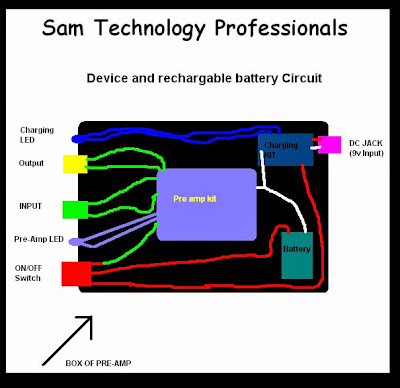This is another microphone pre-amp project from me. I've done it long time ago but didn't have enough time to write down and share all of the data. So, here i'm posting the schematic along with all details including my YouTube video.
The schematic is given below:
The potentiometer at the output is used to set the gain of the output while the other potentiometer is the fixed on board variable resistor what you'll use to set the peak LED indication. Once it is done you can enclose the board inside the metal casing (and connect ground cable with the metal housing/enclosure).
The first two transistors are c1815 which are lowest noise transistors are cascaded in amplifier arrangement. Both transistor stages are amplifying their input signals.
The peak transistor 2n3904 detects the current at the output and when base of this transistor is high it will act as a switch to turn on the LED to indicate the peaking signal of your output. This peaking can be set by adjusting tha 20K variable as i mentioned above.
The capacitor at its input is acting as DC-blocking while the other cap between base and ground is used to hold the base high for a while. 1k resistor at the base is basically for the protection of the transistor's base to prevent high current to flow to the base that can result in blown 2n3904.
The power section is filtered as can be seen in RC filter arrangement mode.
I posted below the video of how i built every thing:
I hope you guys will love this project. If any kind of help is required i'm always available to help you out. You can comment on my YouTube video (posted above) or my facebook page.
Good Luck and Stay blessed. I'll make detailed video about the circuit soon.
The schematic is given below:
The potentiometer at the output is used to set the gain of the output while the other potentiometer is the fixed on board variable resistor what you'll use to set the peak LED indication. Once it is done you can enclose the board inside the metal casing (and connect ground cable with the metal housing/enclosure).
The first two transistors are c1815 which are lowest noise transistors are cascaded in amplifier arrangement. Both transistor stages are amplifying their input signals.
The peak transistor 2n3904 detects the current at the output and when base of this transistor is high it will act as a switch to turn on the LED to indicate the peaking signal of your output. This peaking can be set by adjusting tha 20K variable as i mentioned above.
The capacitor at its input is acting as DC-blocking while the other cap between base and ground is used to hold the base high for a while. 1k resistor at the base is basically for the protection of the transistor's base to prevent high current to flow to the base that can result in blown 2n3904.
The power section is filtered as can be seen in RC filter arrangement mode.
I posted below the video of how i built every thing:
I hope you guys will love this project. If any kind of help is required i'm always available to help you out. You can comment on my YouTube video (posted above) or my facebook page.
Good Luck and Stay blessed. I'll make detailed video about the circuit soon.






















